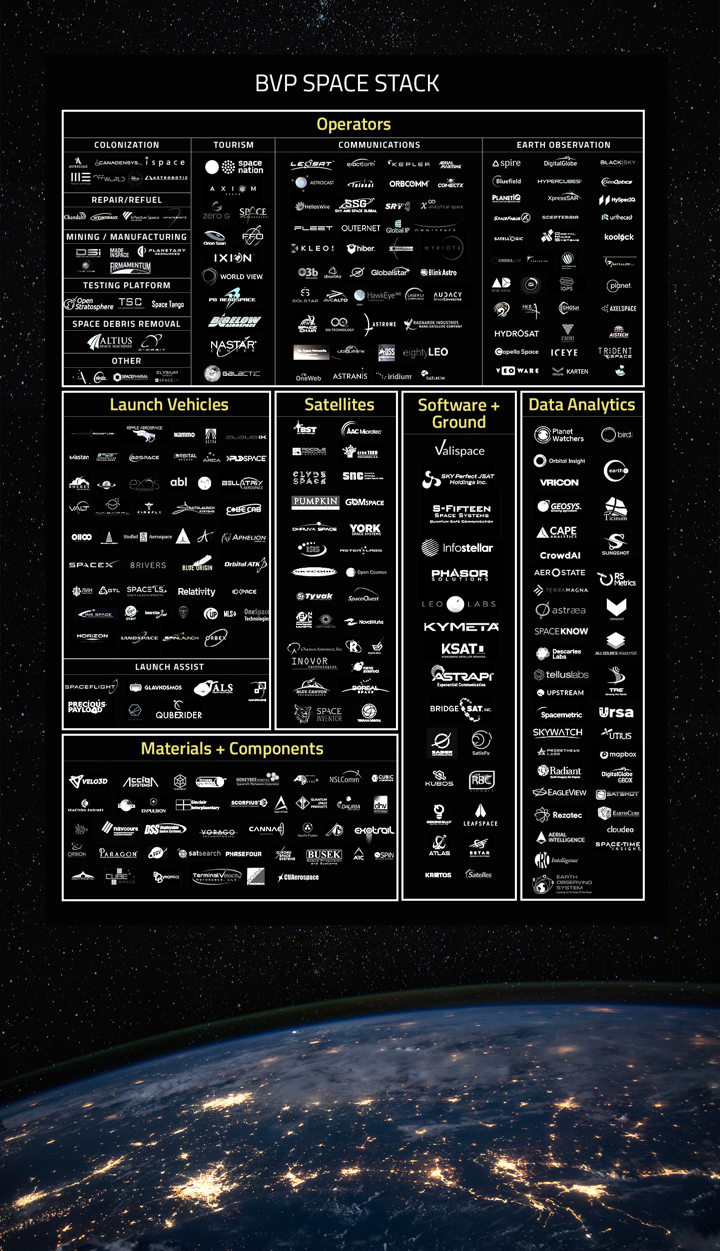INSUBCONTINENT EXCLUSIVE:
David Cowan
Contributor
Share on Twitter
David Cowan is a partner at Bessemer Venture
PartnersBessemer Venture Partners, where he launched the firm investing practices in space tech, cyber security, cloud infrastructure and
consumer tech.
More posts by this contributor
SpaceTech Is Venture Capital Final Frontier
Security For
Startups
Tess Hatch
Contributor
Tess Hatch is an investor at Bessemer Venture Partners, where she
invests in frontier technology, specifically commercial space, quantum computing and drones.
For 50 years, space innovation meant
scaling Apollo-era technologies into ever larger, more durable satellites parked above their terrestrial clients in geosynchronous orbit
Exotic space-ready parts, militarized defenses and layered redundancies ballooned into multi-billion-dollar systems designed to last 40
years or more beyond their conceptions
Only vast organizations with thousands of aerospace engineers could participate.
By the turn of the century, it didn&t matter that
geosynchronous orbit resembled a stadium parking lot on Super Bowl Sunday
The internet had upended and bankrupted the commercial space industry, whose expensive, decades-old satellites could no longer compete with
terrestrial means of moving information
And when a financial crisis gripped the global economy one decade ago, constricting the government budgets that funded most space
exploration, NASA cancellation of its flagship programs seemed to ring the death knell for our colonization of the cosmos.
The space
community was dispirited; no one expected an imminent, explosive emergence of a new entrepreneurial ecosystem that now promises
unprecedented opportunities in space and vanishing barriers to extra-terrestrial commerce
The prospect of colonizing the moon, Mars and beyond now seems likely and even palpable.
The new mindset
Space colonization began in 1957
with the launch of Sputnik, followed by the monumental Apollo program that landed humans on the moon
Both Sputnik and Apollo had to develop their entire missions and supply chains from scratch: rocket engines, spacecraft, avionics software,
space suits, ground stations, mission control software and more.
This monolithic approach dominated space missions for decades… until
In 2010, Brooklynite Luke Geissbühler and his son Max heralded a new model for space exploration when their amateur weather balloon ferried
an iPhone 19 miles above the surface of the Earth, capturing beautiful space images as expensive satellites do
The father-son duo fun experiment exploited the low cost of mass-produced cell phones, whose batteries, antennas, radios, accelerometers and
cameras constitute the most fundamental components of commercial satellites.
Meanwhile, students at Cal Poly and Stanford were using those
same cell phone components to assemble what they called CubeSats— 10x10x10 cm buses designed to cheaply ferry their science experiments to
(In LEO, where satellites naturally de-orbit within five years because of drag from atmospheric particles, they don&t need exotic
radiation-proof parts.) Standard modules for DIY CubeSats can now be procured on hobbyist sites as easily as buying a book on Amazon.
Like
the DARPA engineers who coded the internet protocol, these students hadn&t appreciated the impact of their invention
CubeSats sparked a realization that true scalability comes not from bigger satellites, but many cheap small ones, and suddenly five
accumulated decades of Moore Law turned the space industry upside down.
This new space stack promises a virtuous cycle of innovation,
diversity and growth.
Venture-backed startups like Planet Labs and Skybox (now merged) developed constellations of micro-satellites
to image the Earth far faster than enormous, lumbering incumbents
Other ventures like SpaceX and OneWeb are deploying massive constellations to serve the planet with internet and IoT communications.
The
Silicon Valley teams behind all these constellations naturally focus on software-driven designs with commodity hardware, enabling satellite
operators to quickly launch new apps as we do on our smartphones
The largest general purpose CubeSat constellation — roughly 60 &Lemurs& operated by Spire Global — already monitor ships, planes and
weather.
The new mindset that space is best colonized by smaller, cheaper and faster computers favors entrepreneurial engineering teams
Hundreds of other startups are now exploiting the 100X cost savings of microsat constellations to colonize space.
A new ecosystem
The
microsat revolution demands a new ecosystem to support the operators of these constellations
By far the most important and difficult input to procure is launch, because all mature rocket programs were designed long ago to carry
enormous, expensive payloads to geosynchronous orbit (~36,000 km altitude) with five to 10 years of advance notice; new players like Virgin
Orbitand Rocket Lab promise cheap and frequent carriage to LEO (less than 2,000 km altitude).
Next-gen operators also need ground stations,
mission control software, satellite tracking, data analysis, space Wi-Fi and more
Satellite and rocket manufacturers, in turn, need specialized subsystems, amplifiers, phased array antennas, miniaturized propulsion,
materials, extensible solar panels and batteries
And innovators in additive manufacturing like Velo3D enable SpaceX and Rocket Lab to design and 3D print far more efficient engines.
Space
companies now assemble cheaper, better and faster constellations by mixing and matching off-the-shelf elements from this emerging fragmented
This new space stack (see illustration) promises a virtuous cycle of innovation, diversity and growth akin to the explosion of datacom
startups sparked in the 1980s when the OSI 7-Layerinternet working similarly disrupted an oligopoly of proprietary networks from IBM,
Digital HP and Sun.
Atop the space stack sit the microsat operators that create value for people on Earth
They are extraterrestrial mining companies, agricultural intelligence businesses, pharma manufacturers, internet service providers, weather
forecasters, marine tracking companies and new ones every month
As the space stack grows, these companies look less like scientific research labs and more like their terrestrial competitors.
In other
words, space is open for business
Entrepreneurs are flocking to the final frontier, where Moore Law has unleashed massive, enduring opportunities
This is how humanity will colonize cis-lunar, the moon, asteroids, Mars and beyond — through the emergence of a distributed, commercial
ecosystem infinitely more powerful than any single company or government.
Thanks to Quilty Analytics for their help in building the Space

